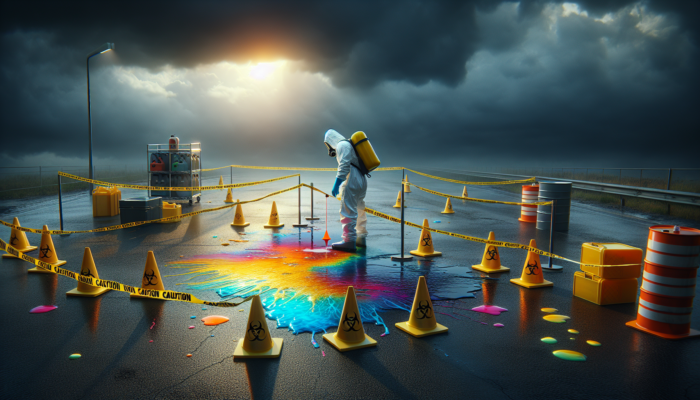Essential Strategies for Safely Managing a Chemical Spill

When confronted with the critical situation of surviving a chemical spill, your immediate actions are crucial to shaping the outcome, determining whether safety prevails or severe harm occurs. The very first action you must undertake is to evaluate the urgency of the incident and respond decisively to protect yourself and others in your vicinity.
Immediately Evacuate the Affected Area to Ensure Safety
Your safety begins with a swift and decisive evacuation from the vicinity of the spill. It is imperative to leave the area without hesitation, particularly when there is a potential for exposure to dangerous chemicals. The unpredictable nature of various substances means that following designated evacuation routes can aid in a rapid and secure escape. Furthermore, urge those nearby to evacuate, as they may also be at risk of inhaling fumes or making contact with hazardous materials, thereby endangering their health.
Evacuating extends beyond merely distancing yourself; it necessitates careful planning of your exit route. Always aim for a predetermined safe zone that is devoid of harmful substances. Keep in mind the wind direction; moving against the breeze can offer an additional safeguard against inhaling toxic vapours.
As you make your exit, maintain awareness of your surroundings. Stay alert for any emerging threats, such as additional spills or reactions that may result from the chemicals involved. Whether in a workplace or public setting, ensuring that all individuals are safely removed from danger is a fundamental first step in effectively surviving a chemical spill.
Communicate the Hazardous Situation to Others Promptly
Effectively communicating the existing peril is of paramount importance. Informing those in close proximity about the incident can help prevent further exposure and alleviate unnecessary panic. If alarms are present, activate them without delay. These alerts can efficiently inform others to evacuate and prompt emergency services to respond more swiftly.
When conveying the situation, utilise clear and direct language to guarantee that everyone comprehends the severity of the spill. In addition to verbal notifications, leverage any available communication systems. Text messages or radio communications can disseminate critical information when shouting is impractical.
It is essential to do more than simply inform; reassuring those nearby is equally important. Foster an atmosphere of calm and direct individuals toward safe exits, assisting in managing the disorder that frequently accompanies such incidents. Ultimately, effective communication can serve as a vital safeguard for lives during the critical moments following a spill.
Contact Emergency Services Immediately for Assistance

Once you are at a safe distance, it is crucial to contact emergency services without delay. Provide them with as much detail as possible about the chemical involved, including its exact location and the extent of the spill. Precision is vital; knowing whether the spill pertains to a corrosive acid, a flammable liquid, or a toxic substance can significantly impact the response strategies employed by the team.
While communicating with emergency responders, strive to remain calm and focused. Inform them of any individuals who have been exposed or if there are injuries that necessitate immediate attention. Remember, your calls can potentially save lives and streamline the response process, enhancing the overall efficiency and effectiveness of emergency services.
While waiting for professional assistance, continue to monitor the situation if it is safe to do so. Observe any developments in the spill or the behaviour of those around you. Maintaining communication with emergency services can facilitate a more coordinated response when responders arrive on the scene.
Key Personal Safety Measures to Adopt During a Chemical Spill
A comprehensive understanding of your vulnerabilities during a chemical spill is essential. Implementing personal protective measures can substantially lessen the risk of exposure to hazardous substances and help mitigate the health threats associated with dangerous materials.
Wear Appropriate Protective Equipment for Maximum Safety
Utilising suitable protective gear is critical during a spill event. Items such as gloves, goggles, and masks are essential in guarding yourself against potential chemical exposure. The type of equipment needed will vary based on the specific substances involved in the spill. For example, a spill involving corrosive chemicals requires gear that can withstand harsh reactions, whereas a spill of organic solvents may demand less stringent protection.
Ensure that your protective gear fits properly and is undamaged before an incident occurs. Well-fitted gloves can prevent chemicals from contacting your skin, while goggles should provide a tight seal to protect your eyes from splashes. A respirator is crucial when chemicals release volatile organic compounds into the atmosphere, as this can safeguard your respiratory health.
Bear in mind that protective equipment is only effective if used appropriately. Familiarise yourself with its limitations and strengths before any incident arises. Understanding the intricacies of surviving a chemical spill entails being thoroughly prepared, including knowledge of how to effectively protect yourself.
Maintain Distance from Hazardous Chemicals to Ensure Safety

In the confusion that often follows a chemical spill, it is vital to maintain a safe distance from the incident zone. Avoid walking through or touching the spill; direct contact can lead to immediate health hazards, including chemical burns or respiratory distress. Protecting your skin and respiratory system should always be your top priority.
Evaluate the situation and determine safe perimeters. Establishing a clearly defined boundary around the spill area can help avert accidental contact and ensure the safety of others. If necessary, utilise visual markers, such as cones or tape, to effectively signify the hazardous area.
If you must approach the spill for any legitimate reason, do so with extreme caution while wearing appropriate protective equipment. Always communicate your intentions clearly to others to prevent them from inadvertently drawing closer to potential danger. The objective is to maintain safety while remaining vigilant about the risks posed by the chemicals involved.
Ensure Adequate Respiratory Protection During Chemical Exposure
When airborne chemicals are present, the risk of inhalation becomes a significant concern. Wearing a respirator can provide critical protection against toxic fumes and vapours. Selecting the appropriate type of respirator is essential; different substances require specific filters to ensure effectiveness and adequate protection.
Prior to an incident, educate yourself about the materials you may encounter in your environment. Knowing which respirator to utilise can save vital moments when time is of the essence. A well-fitted respirator will protect your lungs and enhance your ability to evacuate or assist others effectively during a crisis.
If you are exposed to vapours despite wearing a respirator, it is crucial to seek fresh air immediately. If you experience symptoms such as coughing, wheezing, or difficulty breathing, remove the respirator only after reaching a safe location and seek medical attention promptly.
Adhere to Decontamination Procedures After Potential Exposure
After any potential exposure, following decontamination procedures is vital to ensure no harmful chemicals remain on your skin or clothing. Wash thoroughly with soap and water, paying particular attention to areas that may have come into contact with the spill. This step is crucial for avoiding prolonged exposure and potential health complications.
If designated decontamination stations are available, utilise them. These facilities are equipped to handle chemical residues effectively and can provide additional safety measures. Always adhere to instructions posted at these locations, as they are designed to maximise your safety during decontamination.
In situations where clothing has become contaminated, remove it carefully to prevent spreading the chemical further. Place contaminated garments in sealed bags until they can be disposed of according to local hazardous waste guidelines. Neglecting these critical decontamination steps can lead to ongoing health risks, making it essential to address exposure promptly after the incident.
Proven Strategies for Containment in Chemical Spill Management
Implementing effective containment strategies can prevent a spill from escalating, thereby protecting both individuals and the environment. Understanding how to contain a chemical spill is crucial to mitigating disaster and reducing potential harm.
Apply Absorbent Materials to Control and Contain Chemical Spills
When confronted with a chemical spill, deploying absorbent materials such as sand or specialised spill kits can significantly hinder the spread of the hazardous substance. These materials work by soaking up the liquid, effectively containing the spill and making cleanup safer and more manageable.
Utilising absorbents not only contains the chemical but also helps reduce the risk of fire or additional reactions that may occur upon contact with other materials. Timing is critical in this operation; the rapid application of absorbents can vastly improve safety outcomes. Equip yourself with a spill response kit beforehand, ensuring it contains an adequate supply of absorbent materials suited for the chemicals you might encounter.
Always adhere to the guidelines for the specific absorbents in use. Some absorbents may not be suitable for certain chemicals, and employing the wrong type can complicate cleanup efforts. Knowledge of these materials can be invaluable in the heat of the moment, allowing for swift action and effective containment.
Establish Physical Barriers to Prevent the Spread of Spills
Physical barriers can be instrumental in preventing the spread of a chemical spill. Setting up obstacles around the spill can limit its expansion and protect nearby areas from contamination. Materials such as booms or dikes serve as effective containment solutions specifically designed for this purpose.
When constructing barriers, consider the chemical properties of the spilled substance. Some materials may react adversely with specific chemicals, so ensure that your chosen barriers are compatible. For instance, absorbent booms are particularly effective for oil spills, while other types may be more suitable for hazardous solid materials.
Monitoring the spill as you establish barriers is critical. Observe for changes in behaviour or movement of the substance, as these factors can dictate your containment strategy. The goal is to create a protective zone that limits the spill while ensuring your safety and that of those nearby.
Implement Strategies to Minimise Environmental Impact from Chemical Spills
The ramifications of a chemical spill extend beyond immediate health risks; they can devastate the environment. Taking proactive measures to prevent a spill from reaching drains or waterways is essential. Effective containment methods not only protect individuals but also safeguard ecosystems and communities downstream from potential harm.
Implementing diversion techniques can redirect the flow of chemicals away from sensitive areas such as storm drains or water sources. This can involve using absorbent materials to create barriers that channel the liquid away from vulnerable zones, effectively minimising the risk of environmental contamination.
In the aftermath of a spill, collaborate with environmental agencies to assess the potential impacts and determine the necessary cleanup protocols. Documenting the incident and reporting it to the relevant authorities can facilitate preventative measures in the future, ensuring a safer environment for all community members.
Thorough Cleanup Procedures to Follow Following a Chemical Spill
The cleanup process following a chemical spill is a critical phase that must be approached cautiously. Adhering to safety protocols during this time will protect individuals involved and ensure the effective removal of hazardous materials from the affected area.
Follow Established Safety Protocols During the Cleanup Process
Established safety guidelines should govern every step of the cleanup process. Adherence to these protocols is not merely about compliance; it’s about safeguarding health and minimising risks associated with hazardous materials. Whether through the use of appropriate tools or implementation of specific techniques, following safety protocols ensures that cleanup is conducted as safely and efficiently as possible.
Before beginning the cleanup, conduct a thorough risk assessment. Understand the nature of the chemicals involved and the potential hazards they pose. Equip yourself with proper personal protective equipment (PPE) to mitigate exposure risks. Depending on the chemical's properties, this may include gloves, goggles, and respiratory protection.
During the cleanup, maintain clear communication with your team. Assign roles based on expertise and ensure that everyone understands their responsibilities. This can streamline the process and prevent confusion, ultimately contributing to a more effective cleanup operation.
Dispose of Contaminated Waste Responsibly and Safely
The disposal of contaminated materials must be handled with extreme care. Used absorbents, protective gear, and other waste must be disposed of according to local regulations regarding hazardous waste. Failure to follow these regulations can result in serious legal and environmental consequences.
Identify designated hazardous waste disposal facilities and ensure that your team understands the process for safely transporting waste. If possible, label all contaminated materials to prevent accidental contact during disposal. Keeping clear records of what materials were disposed of and how can also aid in future safety planning and compliance.
Remember that improperly disposed of materials can lead to secondary incidents, posing risks to public safety and the environment. Staying informed about best practices in hazardous waste management can significantly ensure a safe and effective cleanup.
Thoroughly Document the Incident for Future Improvements
Comprehensive documentation of the spill and cleanup process is essential for future safety improvements and regulatory compliance. Recording details such as the type of chemical involved, the response actions taken, and the final cleanup results can provide valuable insights into the effectiveness of the response.
Immediately after the incident, gather information from all team members involved. This should include photographs, witness statements, and observations made during the incident. This comprehensive record will assist in reporting to relevant authorities and aid in training for future spill responses, contributing to enhanced preparedness.
Utilising the insights gained from this documentation, organisations can identify and rectify weaknesses in their spill response plans. Continuous improvement is key to better preparedness and safety in the face of potential future spills.
Health Monitoring Practices to Implement After a Chemical Spill
The aftermath of a chemical spill extends beyond immediate actions; ongoing health monitoring is crucial for everyone involved. Ensuring that individuals are aware of potential symptoms can lead to early detection and timely intervention, thereby minimising health risks associated with exposure.
Vigilantly Monitor for Symptoms of Chemical Exposure
Monitoring for symptoms of chemical exposure should be a priority for anyone potentially affected by the spill. Early signs can range from mild skin irritation to severe respiratory distress. Be vigilant and encourage others to report unusual symptoms immediately to ensure prompt medical evaluation.
Educate your team on the specific symptoms associated with the chemicals involved in the spill. This knowledge can empower individuals to take proactive measures if they feel unwell. Establishing a system for monitoring health can help track any emerging issues, ensuring that no one slips through the cracks and allowing for timely medical intervention if required.
Promptly Seek Medical Attention When Symptoms Arise
If symptoms develop following a chemical spill, seeking immediate medical attention is critical. Inform healthcare providers about the chemicals involved, as this information will guide their treatment approach and ensure that individuals receive appropriate care.
Documenting symptoms and responses can provide valuable context for medical professionals, enabling them to assess the situation more accurately and provide effective treatment. Don’t hesitate to seek help; early intervention can significantly improve outcomes in cases of chemical exposure, ultimately safeguarding health.
Encourage an environment where individuals feel comfortable discussing their health concerns. Stigma should never prevent someone from seeking medical assistance, particularly after a potentially hazardous incident. Open communication can foster a culture of safety and care.
Establish Follow-Up Protocols for Ongoing Health Monitoring
Ongoing health monitoring should be integral to your recovery plan after a chemical spill. Observing any developments or changes in health is critical, as some effects may not be immediately apparent. Keep records of health issues and follow up with healthcare providers for long-term care recommendations.
Establish a follow-up schedule for check-ups to ensure that no lingering complications arise. This process can provide peace of mind to those affected, ensuring they receive the necessary care and support. Regular assessments can aid in identifying any long-term effects of chemical exposure.
Once again, communication is key. Sharing information about health monitoring can reassure others about the importance of ongoing awareness and vigilance regarding their well-being and health following a chemical incident.
Report Incidents to Relevant Authorities for Accountability
Documenting and reporting incidents of chemical exposure should not be overlooked. Sharing details with relevant authorities or workplace safety departments can lead to better understanding and prevention measures in the future. It also contributes to an overall culture of workplace safety and accountability.
Encourage transparency and a culture of reporting within your organisation. The more information shared, the better prepared everyone will be for a future spill. Reporting not only aids in compliance; it creates an opportunity for learning and growth, ultimately enhancing the well-being of all employees.
Comprehensive Training and Preparedness for Chemical Spill Response
Training and preparedness are vital components in effectively responding to a chemical spill. Regular practice can instil confidence and enhance the speed of response when it matters most, ensuring that all team members are equipped to handle such emergencies.
Conduct Regular Spill Response Drills to Maintain Readiness
Regular spill response drills are essential for maintaining readiness within your team. Practising evacuation and containment procedures can significantly improve response times and ensure everyone knows their roles and responsibilities during an emergency. These drills should simulate potential real-life scenarios, enabling teams to effectively familiarise themselves with processes and equipment.
Feedback from participants should always be gathered after conducting drills. Discuss what went well and identify areas for improvement. Engaging in this reflective practice can refine your response strategies, ensuring your team is well-prepared for any possible incident.
Documenting these drills also creates a record of preparedness efforts, which can be beneficial for compliance and safety audits and showcases the organisation’s commitment to safety and readiness.
Educate Staff on Chemical Safety Protocols and Emergency Procedures
Investing in education around chemical safety and spill response pays dividends in terms of preparedness. Ensure that employees understand the risks associated with the chemicals they work with and know how to act effectively in an emergency.
Training sessions should cover specific procedures for different types of spills and the correct use of protective gear and containment methods. Regular refreshers will keep safety at the forefront of everyone’s mind, reinforcing the importance of preparedness.
Encourage open dialogue about chemical safety. Creating an environment where employees feel comfortable asking questions or raising concerns can lead to a safer workplace overall and enhance the team’s ability to respond to spills and other emergencies.
Maintain Spill Response Equipment in Optimal Working Condition
Keeping spill response equipment in good condition is crucial for effective incident response. Regularly check and restock supplies to ensure everything is ready for use when needed, minimising downtime in emergencies.
This includes inspecting personal protective equipment (PPE) for damage and ensuring that spill kits are fully stocked with absorbent materials, tools, and safety gear. Establish a maintenance schedule to ensure all equipment remains in optimal condition and ready to be deployed immediately.
Understanding how to use each piece of equipment is equally important. Regular training on the proper use of spill response equipment will ensure that, in the event of a spill, your team can respond swiftly and effectively, minimising risks to health and safety.
Effective Prevention Strategies to Minimise Chemical Spill Risks
When it comes to chemical spills, prevention is always better than cure. Implementing effective prevention strategies can significantly reduce the risk of incidents occurring in the first place, creating a safer working environment for everyone.
Ensure Proper Storage of Chemicals to Prevent Potential Spills
Proper chemical storage is one of the most effective strategies for preventing spills. Ensure all chemicals are stored in approved containers and clearly labelled to avoid confusion. Maintaining an organised storage area reduces the risk of accidents and facilitates quick access to materials when needed.
Segregate incompatible substances to prevent hazardous reactions. Utilising secondary containment systems can also provide an additional layer of security, containing any leaks or spills that may occur and preventing them from spreading.
Regularly review your storage practices and protocols to ensure compliance with best practices and regulations. Training employees on proper storage techniques can further reinforce the importance of safety, fostering a culture of responsibility regarding chemical management.
Implement Ongoing Education and Training Initiatives for Staff
Ongoing education about chemical hazards and spills is crucial for prevention. Conduct training sessions to ensure staff understand the risks associated with the substances they work with and the correct procedures for handling and storing them safely.
Encourage a culture of safety where employees feel empowered to speak up about unsafe practices or conditions. This creates a safer environment and fosters teamwork and accountability among staff members, enhancing overall safety.
Implementing comprehensive education and training programmes can significantly reduce the likelihood of spills and enhance the overall safety culture within your organisation, leading to a more prepared workforce.
Conduct Regular Inspections to Identify and Mitigate Hazards
Regular inspections of facilities and equipment can identify potential hazards before they escalate into serious issues. Establishing a routine inspection schedule allows teams to proactively address concerns and mitigate risks.
Focus on areas where chemicals are handled or stored. This includes checking for leaks, assessing the condition of containers, and ensuring that safety equipment is accessible and functional. Regular inspections can help catch minor issues before they develop into larger, more significant problems.
Incorporating inspection findings into ongoing training and operational practices can enhance safety measures. Staying vigilant about potential risks can significantly reduce the likelihood of chemical spills, contributing to a safer workplace.
Frequently Asked Questions About Effective Chemical Spill Management
What should I do immediately after a chemical spill occurs?
Evacuate the area immediately, alert others nearby, and contact emergency services with details about the spill.
How can I protect myself during a chemical spill?
Wear appropriate protective gear, avoid direct contact with the spill, and use respiratory protection.
What are the signs of chemical exposure I should watch for?
Symptoms can include skin irritation, breathing difficulties, nausea, or dizziness. Seek medical attention if any symptoms occur.
What is the proper way to dispose of contaminated materials after a spill?
Follow local regulations for hazardous waste disposal and ensure that contaminated materials are securely sealed before transporting.
How can I prepare for a potential chemical spill in my environment?
Conduct regular drills, educate staff on chemical safety, and maintain spill response equipment in good condition.
What should I include in an effective spill response kit?
A spill response kit should include absorbent materials, protective gear, containment tools, and clear instructions for use.
How can I prevent chemical spills from occurring in the workplace?
Implement proper storage practices, conduct regular inspections, and provide ongoing employee education on chemical safety.
To whom should I report a chemical spill incident?
As required, report the spill to emergency services, your workplace safety department, and relevant environmental authorities.
What are the environmental impacts of chemical spills?
Chemical spills can contaminate soil and water, harm wildlife, and disrupt ecosystems, making proper containment and cleanup critical.
Can I clean up a chemical spill myself?
Only attempt cleanup if you have appropriate training and protective equipment. Otherwise, wait for professionals to respond.
Explore our world on X!
The post Surviving a Chemical Spill: Essential Tips and Actions appeared first on Survival Bite.
The Article Essential Tips and Actions for Surviving a Chemical Spill Was Found On https://limitsofstrategy.com

